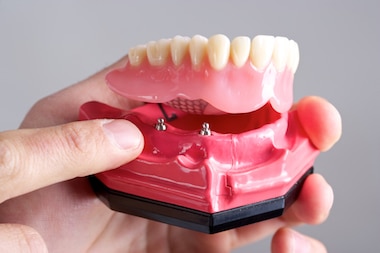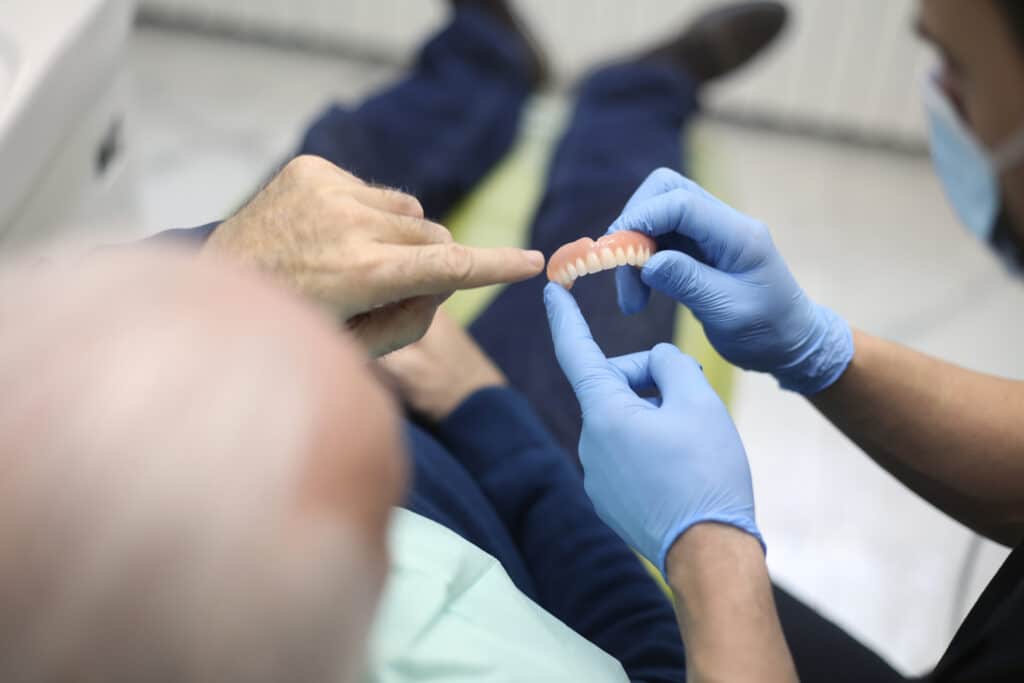
Snap-in dentures, also called overdentures or implant-supported dentures, provide a secure and comfortable alternative to traditional removable dentures. Snap-in dentures are similar to traditional dentures in some ways, but there are also some important differences. Let’s take a look at snap-on dentures, what they are, and their pros and cons.
What Are Snap-In Dentures?
Snap-in dentures are a type of denture that attaches to dental implants placed in the jawbone. These implants serve as anchor points, allowing the denture to snap into place securely. Unlike traditional dentures, which rely on adhesives or suction to stay in place, snap-in dentures provide a more stable fit, making it easier to eat and speak without worry.
While snap-in dentures are more secure than traditional dentures, they are still removable. They can be taken out for cleaning and should be removed before sleeping to prevent unnecessary pressure on the gums and implants. This removability makes them different from permanent implant-supported dentures, which are fixed in place and can only be removed by a dentist.
Getting Snap-In Dentures
Getting snap-in dentures requires multiple steps and can take several months to complete. The process begins with an evaluation by a dentist. At this appointment, a dentist will determine if you have enough healthy bone to support implants. If there is significant bone loss, bone grafting may be required before the implants can be placed.
The next step involves surgically placing the implants into the jawbone. Typically, snap-in dentures require two to six implants per arch, depending on your needs and bone structure. After the implants are placed, they need time to integrate with the bone—a process called osseointegration—which can take several months.
Once the implants have fused with the jawbone, your dentist will place attachments on top of the implants, allowing the dentures to snap into place. The final step involves fitting and adjusting the dentures to make sure they are comfortable and working properly.
How to Care for Snap-In Dentures
Maintaining snap-in dentures requires a combination of daily cleaning and regular dental visits. Since these dentures are removable, you should take them out at night and clean them thoroughly. Brushing the dentures with a soft-bristled toothbrush and non-abrasive cleaner helps remove food particles and plaque. It’s also important to clean the gums and implant attachments to prevent irritation or infection.
Regular dental checkups are essential to monitor the condition of both the dentures and the implants. Over time, the attachments on the dentures may wear out and need to be replaced to maintain a secure fit. If there are any signs of discomfort, irritation, or difficulty snapping the dentures into place, you should consult with your dentist as soon as possible.
Pros and Cons of Snap-In Dentures
There are several advantages of snap-in dentures compared to traditional dentures, but there are some disadvantages to be aware of as well. Let’s take a closer look at each.
Pros of Snap-In Dentures
One of the biggest advantages of snap-in dentures is their improved stability compared to traditional dentures. Because they attach to implants, they don’t slip or shift while eating or speaking, making them feel more natural and secure. This added stability can also make it easier to eat a wider variety of foods without discomfort.
Snap-in dentures are more comfortable than traditional dentures because they put less pressure on the gums. Since they are anchored to implants, they don’t rely on suction or adhesives, eliminating the need for messy denture creams. Additionally, because they are removable, they are easier to clean and maintain than permanent implant-supported dentures.
Another benefit of snap-in dentures is that they help preserve jawbone health. When teeth are missing, the jawbone can deteriorate over time due to lack of stimulation. Dental implants provide stimulation to the bone, helping to slow or prevent bone loss, which can maintain facial structure and prevent the sunken appearance that often accompanies tooth loss.
- More stable than traditional dentures
- Easier to eat with
- No need for denture creams or adhesives
- Since they are removable, they are easy to clean
- Preserves jawbone health and face shape
Cons of Snap-In Dentures
While snap-in dentures offer many benefits, they also come with some drawbacks. One of the biggest disadvantages is the cost. Because they require surgical implant placement, they are more expensive than traditional dentures. The cost varies depending on the number of implants needed, the materials used, and any additional procedures, such as bone grafting. While they are more affordable than full fixed implant-supported dentures, they still require a significant investment.
The process of getting snap-in dentures can also take several months. Between implant placement, healing, and denture fitting, it may be a long wait before you can fully enjoy the benefits of new teeth. Additionally, since snap-in dentures are removable, they may not feel as permanent or seamless as fixed implant-supported dentures.
Another consideration is maintenance. While snap-in dentures are more stable than traditional dentures, they still require regular removal and cleaning. The attachments that connect the dentures to the implants can wear down over time and need periodic replacement. If they are not properly cleaned, plaque and bacteria can accumulate around the implants, potentially leading to infections, which can compromise the implants’ stability.
- More expensive than traditional dentures
- Requires several procedures and a long healing process
- Since they are removable, they might not feel as permanent as fully fixed dentures
- Requires attentive cleaning and regular check-ups to maintain a comfortable fit
Who Are Snap-In Dentures Best For?
Snap-in dentures are a good option for those who want a more secure alternative to traditional dentures, but don’t want or cannot afford fully fixed implant-supported dentures. They are especially beneficial for people who have difficulty keeping traditional dentures in place or who experience discomfort due to gum irritation.
They may also be a good choice for individuals with some degree of jawbone loss, as fewer implants are required compared to fixed full-arch implant solutions. People who are looking for a balance between stability and affordability may find snap-in dentures to be a practical solution.
Snap-in dentures can be a happy medium between dentures that are fully fixed using implants and dentures that are fully removable. Regardless of which option you prefer, a good understanding of each one will help you make the right decision. Make an appointment with a dentist today to discuss your options and learn more about the different dentures available.


